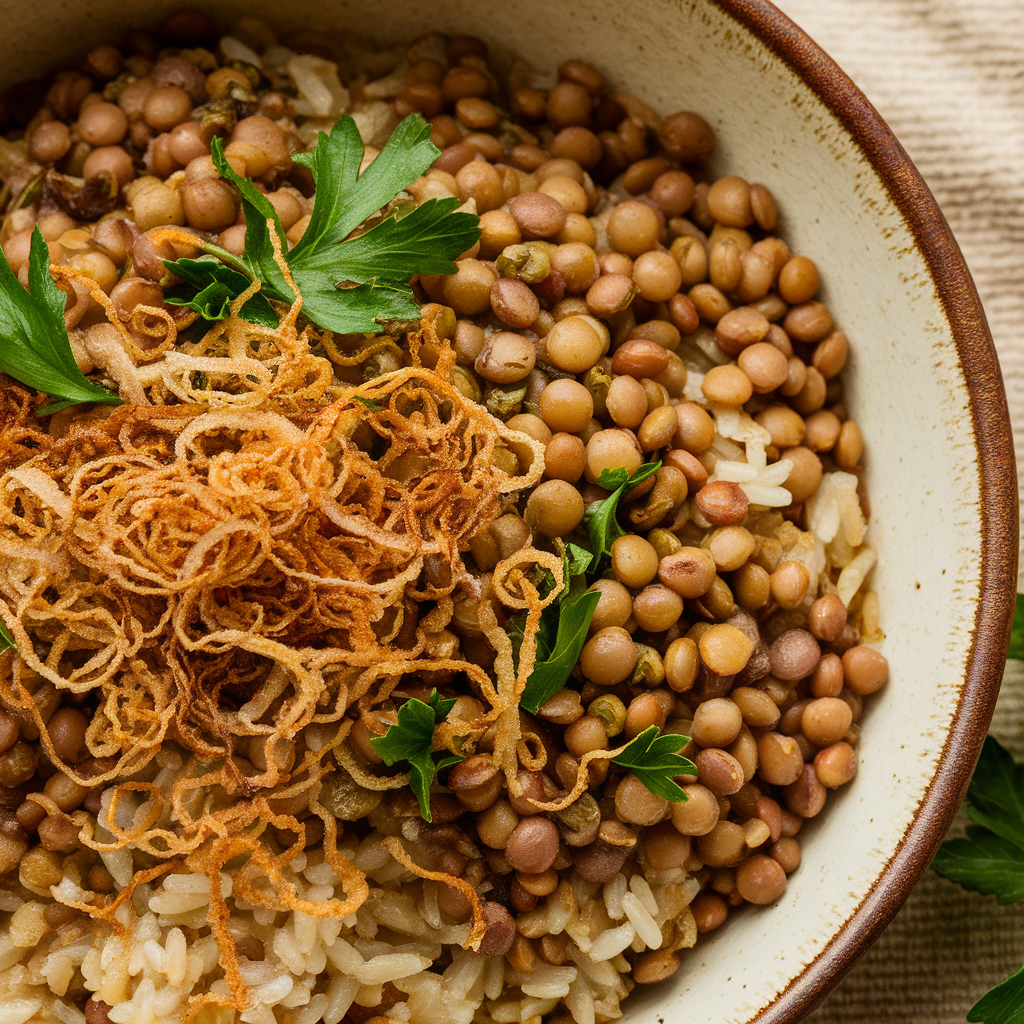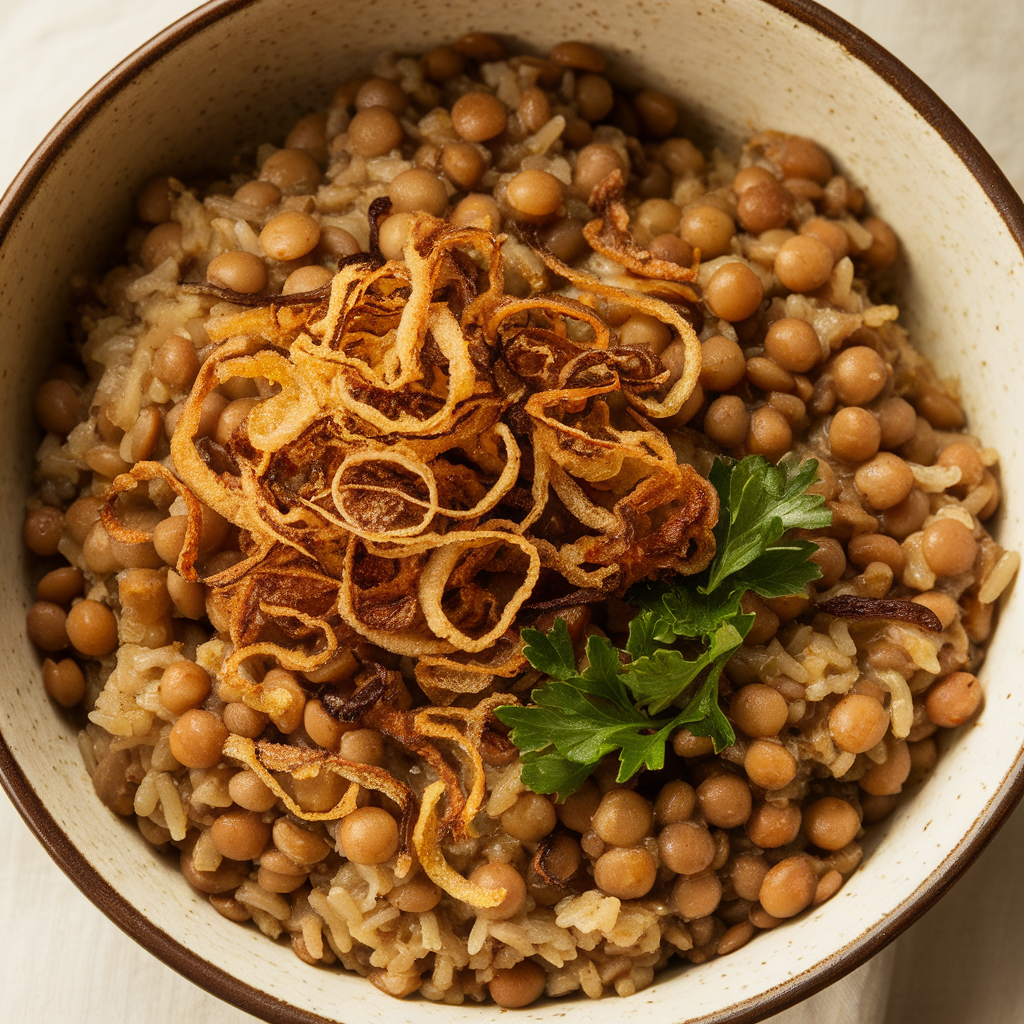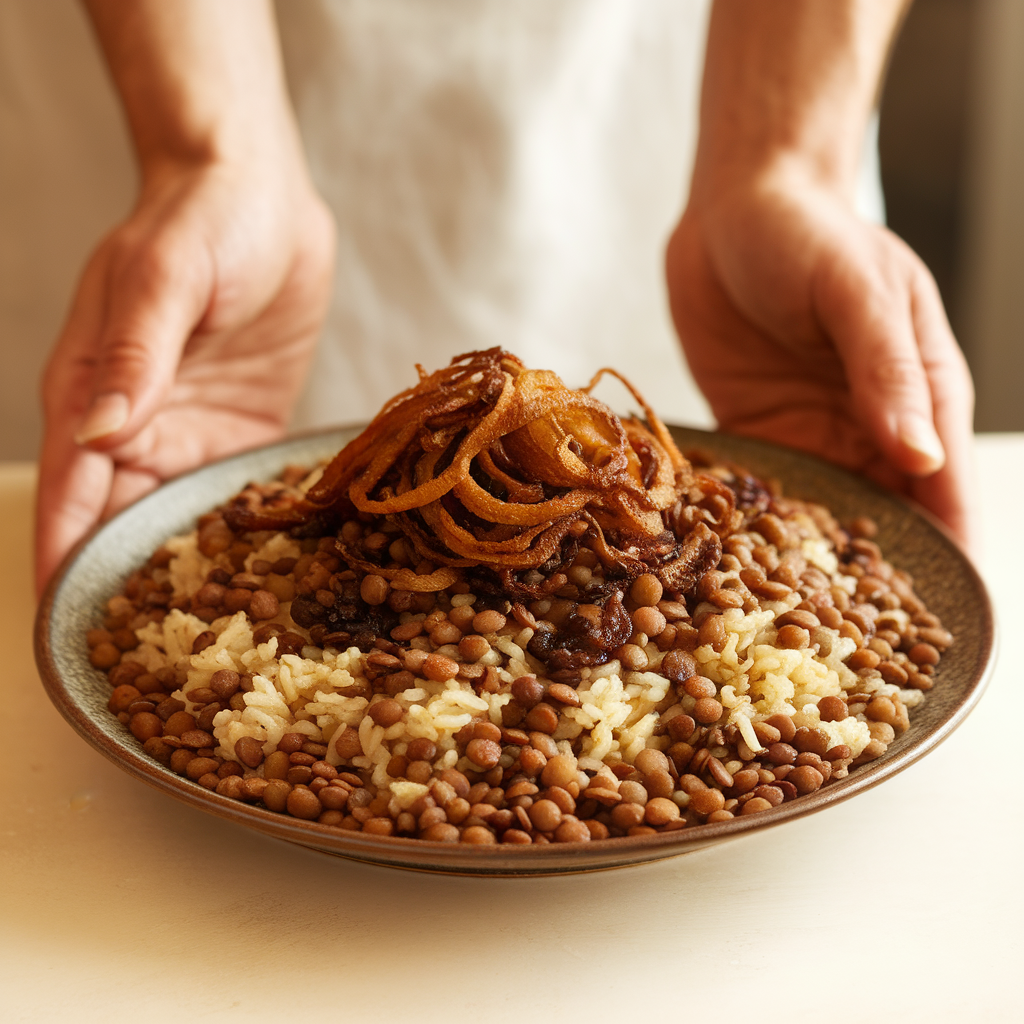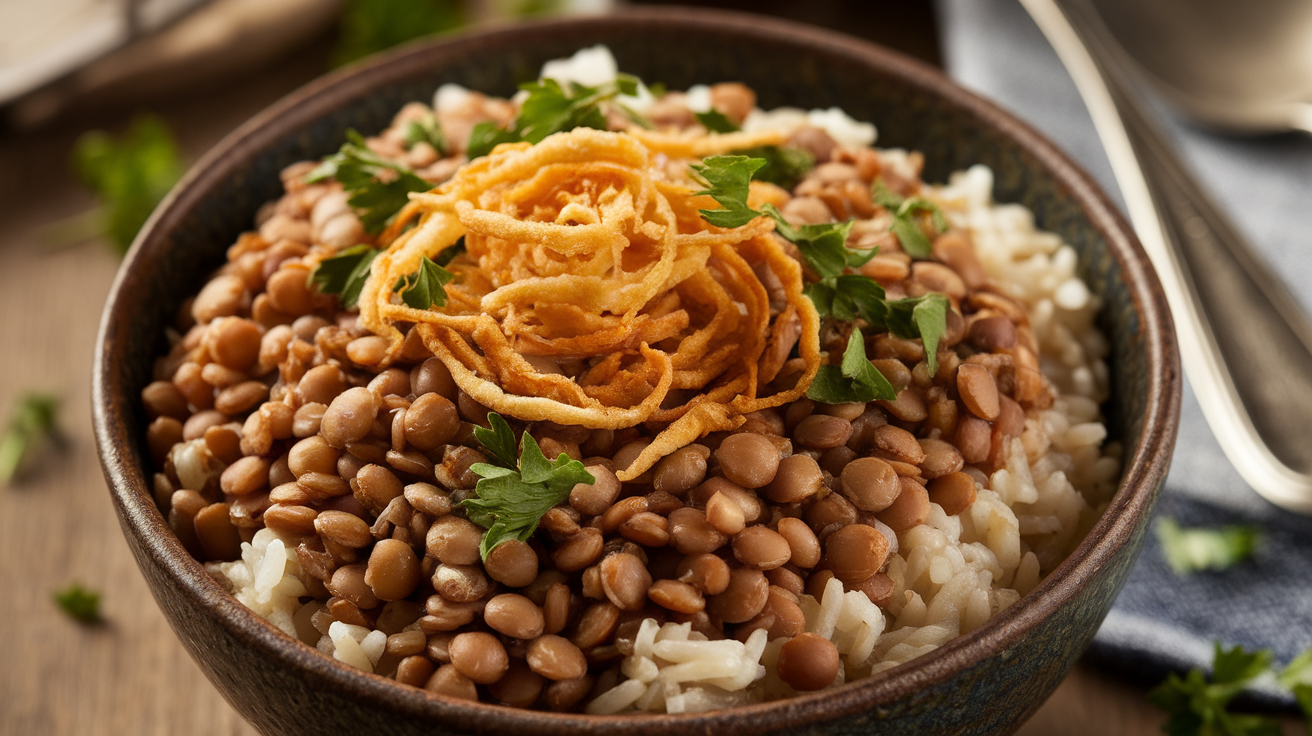Mujadara is a beloved dish throughout the Middle East, celebrated for its simplicity, hearty flavors, and nutritious ingredients. At its core, Mujadara combines lentils and rice cooked together and topped with crispy, caramelized onions. This humble dish is often referred to as “poor man’s food,” but its rich taste and satisfying texture have earned it a permanent spot in many homes and restaurants worldwide.
Whether you’re exploring Middle Eastern cuisine for the first time or looking for a healthy, budget-friendly meal, Mujadara is an excellent choice. In this article, we will dive deep into the origins of Mujadara, share a traditional Lebanese recipe, discuss its health benefits, and offer tips for perfecting this delicious lentils and rice dish.
What is Mujadara?
Mujadara (also spelled Mujaddara, Mjadra, or Mujadara) is a traditional Middle Eastern dish made primarily of lentils, rice (or bulgur), and fried onions. The name “Mujadara” translates to “pockmarked” or “spotted” in Arabic, referring to the speckled appearance lentils create within the rice.
It is a staple food across many countries such as Lebanon, Syria, Palestine, Jordan, and Iraq, with each region offering slight variations in preparation and seasoning. Mujadara is a vegetarian and vegan dish by nature, often served with yogurt, salad, or pickled vegetables.
Historical and Cultural Background
Mujadara has ancient roots, dating back thousands of years in the Levant region. Lentils are one of the oldest cultivated crops, making this dish a natural, economical, and nutritious meal for people of all social classes.
In Lebanese culture, Mujadara is a comfort food, often prepared during Lent or on meatless days. It’s also a popular dish during Ramadan and other religious observances where simple, wholesome meals are preferred.
This dish exemplifies the Mediterranean and Middle Eastern philosophy of making the most of basic ingredients, balancing flavor, nutrition, and affordability.

Ingredients Overview
The simplicity of Mujadara is part of its charm. The key ingredients are:
- Brown or green lentils: These hold their shape well after cooking.
- Long-grain rice or basmati rice: The rice cooks with the lentils, absorbing their flavor.
- Onions: Thinly sliced and fried until deeply golden and crispy — the crowning glory of the dish.
- L'huile d'Olive: Used for frying onions and cooking lentils and rice.
- Les épices: Typically cumin and allspice, but regional variations may include cinnamon, coriander, or bay leaves.
- Le sel et le poivre: To taste.
Optional garnishes and sides include fresh parsley, lemon wedges, plain yogurt, or a simple salad like fattoush or tabbouleh.
Health Benefits of Mujadara
Mujadara is not only tasty but highly nutritious:
- High in protein and fiber: Lentils provide plant-based protein and dietary fiber, aiding digestion and satiety.
- Low in fat and cholesterol-free: A heart-healthy meal when cooked with olive oil.
- Rich in minerals: Lentils and rice offer iron, magnesium, potassium, and B vitamins.
- Gluten-free and vegan: Suitable for many dietary restrictions.
- Affordable and sustainable: Lentils and rice are inexpensive pantry staples with a low environmental footprint.
Step-by-Step Recipe for Mujadara: Lentils and Rice with Crispy Onions
Ingrédients
- 1 cup brown or green lentils, rinsed
- 1 cup long-grain white rice or basmati rice, rinsed
- 3 large onions, thinly sliced
- 4 tablespoons olive oil, divided
- 3 cups water or vegetable broth
- 1 cuillère à café de cumin moulu
- 1/2 teaspoon ground allspice (optional)
- Sel et poivre, au goût
- Fresh parsley (optional, for garnish)
- Lemon wedges (optional, for serving)

Instructions
1. Prepare the Lentils
Place the lentils in a medium saucepan and cover with water by about 2 inches. Bring to a boil, then reduce heat and simmer uncovered for about 15 minutes. The lentils should be tender but not mushy.
Drain lentils and set aside.
2. Fry the Onions
While the lentils cook, heat 3 tablespoons of olive oil in a large skillet over medium heat.
Add the thinly sliced onions and a pinch of salt. Stir occasionally and fry until the onions become deeply golden brown and crispy, about 20-25 minutes.
Be patient: the caramelized onions are essential for authentic flavor and texture. Remove the onions with a slotted spoon and drain on paper towels.
3. Cook the Rice and Lentils
In the same pot used for lentils (or a clean pot), heat the remaining 1 tablespoon of olive oil.
Add the drained lentils back in along with the rinsed rice.
Stir in cumin, allspice (if using), salt, and pepper.
Pour in 3 cups of water or vegetable broth. Bring to a boil, then reduce heat to low, cover tightly, and simmer for 15-20 minutes, or until the rice is cooked and the liquid is absorbed.
4. Combine and Serve
Once the rice and lentils are cooked, gently fluff with a fork.
Top the Mujadara with a generous amount of crispy fried onions.
Garnish with chopped parsley and serve with lemon wedges on the side.
For an authentic touch, serve Mujadara alongside plain yogurt or a fresh cucumber-tomato salad.
Tips for Perfect Mujadara
- Use the right lentils: Brown or green lentils hold their shape well and don’t turn mushy.
- Don’t rush the onions: Crispy caramelized onions make the dish stand out. Fry them slowly on medium-low heat.
- Rinse rice and lentils: Removes excess starch and prevents the dish from becoming gummy.
- Use vegetable broth: For extra flavor, replace water with broth.
- Adjust spices: Try adding cinnamon, coriander, or even a pinch of turmeric for different flavor profiles.
- Make it vegan: Mujadara is naturally vegan; just skip any dairy toppings.
- Leftover ideas: Mujadara makes a great base for salads or stuffed vegetables.

Variations of Mujadara Across the Middle East
- Lebanese Mujadara: Classique with fried onions and cumin.
- Palestinian Mujadara: Often served with sumac sprinkled on top and accompanied by plain yogurt.
- Syrian Mujadara: Sometimes includes bulgur wheat instead of rice.
- Iraqi Mujadara: May include a pinch of cinnamon and nutmeg for a warm, fragrant flavor.
Each regional variant has subtle nuances but keeps the heart of Mujadara intact — a simple, filling lentils and rice dish topped with crispy onions.
Why Mujadara is a Must-Try Mediterranean Dish
Mujadara is much more than a humble rice and lentil dish. It embodies the essence of Middle Eastern home cooking — resourceful, flavorful, and nourishing. It’s the perfect example of how basic pantry staples can be transformed into a delicious meal with just a few ingredients and simple techniques.
If you’re looking to expand your culinary horizons, Mujadara offers an easy entry point into Arabisk Mad (Arabic food) and the broader world of Mediterranean and Middle Eastern dishes. It’s a fantastic choice for anyone seeking healthy, plant-based recipes with authentic flavors.
Serving Suggestions for Mujadara
- Serve warm or at room temperature.
- Pair with a fresh salad like fattoush or tabbouleh for a complete meal.
- Add a dollop of Greek or labneh yogurt for creaminess.
- Offer lemon wedges on the side for a zesty contrast.
- For a heartier meal, serve alongside roasted vegetables or grilled meats.
Storing and Reheating Mujadara
Mujadara keeps well in the refrigerator for up to 4 days. Store in an airtight container.
To reheat, sprinkle a little water and warm gently on the stove or microwave until heated through.
It also freezes well for up to 3 months. Thaw overnight in the fridge before reheating.
Mujadara in Modern Healthy Diets
With its high fiber, protein, and low-fat profile, Mujadara fits beautifully into many contemporary eating styles:
- Mediterranean diet: Rich in plant foods and healthy fats.
- Vegetarian and vegan diets: A complete meal without animal products.
- Gluten-free diets: Naturally gluten-free when made with rice.
- Budget-friendly eating: Affordable, nutritious, and filling.
Réflexions Finales
Mujadara: Lentils and Rice with Crispy Onions is a delicious and versatile dish that deserves a spot on your weekly meal plan. Its rich history, ease of preparation, and balanced nutrition make it a perfect example of how Middle Eastern cuisine celebrates simplicity and flavor.
Try the recipe today, and enjoy a taste of the Mediterranean that’s wholesome, comforting, and utterly satisfying.


